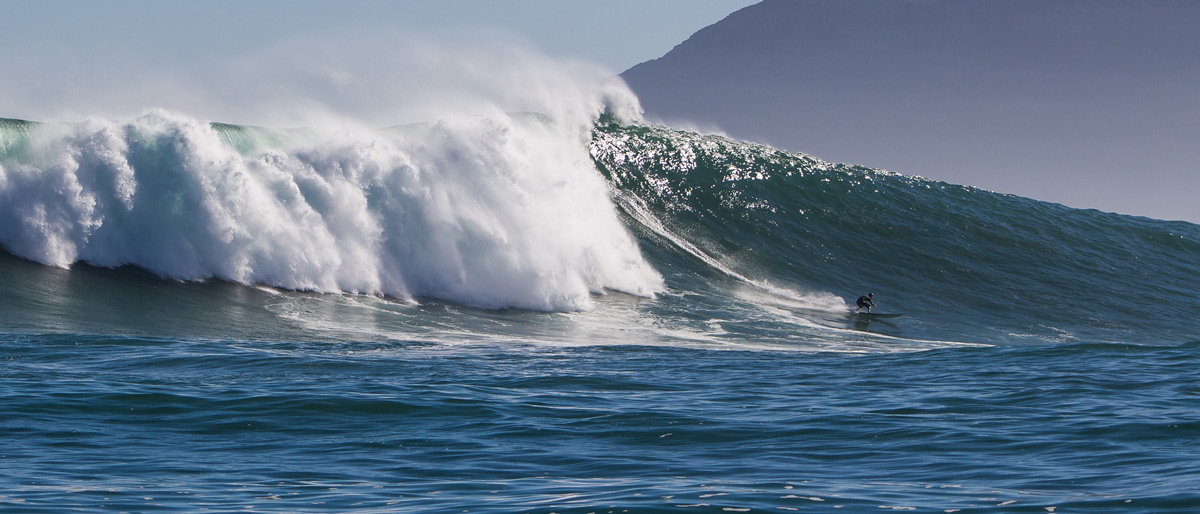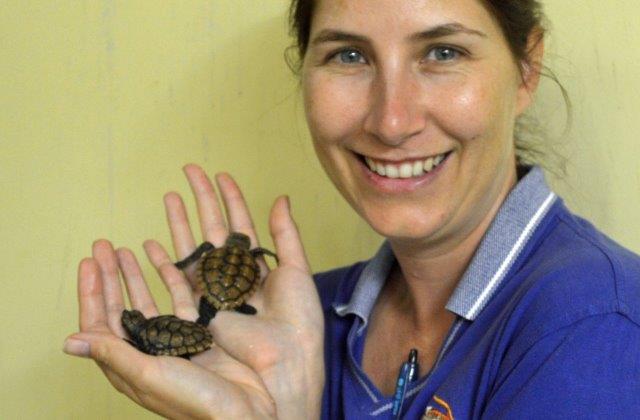A stretch of coast earmarked for seismic surveys – and potentially oil and gas extraction – lies on a long route followed by humpback whales.
by Rio Button for Roving Reporters
Amid the blur of the hundreds of whale surveys Delport has done over the past five years, he will always remember this one. “Witnessing a humpback whale birth was incredible,” he says. The 26-year-old South African is the director of operations and head diving instructor at MAR Expeditions, a small conservation research and ecotourism organisation, in the remote village of Zavora.
Delport tells me he hears humpbacks singing on every scuba dive in peak whale season, from June to September in Zavora Bay. These whales come up from their feeding grounds in the chilly waters of the Southern Ocean which surrounds Antarctica, migrate as far up Africa’s east coast as Somalia to give birth and mate. Humpbacks are famous for being the most acrobatic and playful whale species. They are also one of global conservation’s greatest success stories.
Pressing pause on whaling
The global humpback whale population was down by 90% when the International Whaling Commission swooped in to safeguard what remained of their dwindling population. In 1982 the commission instituted a pause on commercial whaling for all species from the 1985/86 season onwards. This “commercial whaling moratorium” remains in force today. However, Norway, Iceland and Japan still catch whales commercially. Despite this, the moratorium is regarded as a real breakthrough. Thanks to it, decimated populations have recovered in many of the world’s oceans.
But whales aren’t out of the woods yet. Humpbacks, knobbly faced gentle giants, still face many human-made threats. Fishing gear, particularly octopus and crayfish traps in South Africa, entangle them. They are hit and harassed by vessels and artificial underwater noise takes its toll on these ocean migrants.
Now, with preparations under way for seismic surveying off the Wild Coast, environmentalists are concerned the underwater booms this will entail may harm humpbacks. And if the survey ship does find what it’s after – oil and gas in economic quantities – drilling and extraction may in time risk oil spills and other devastation to a largely unspoiled region.
Critics of the survey plans, which were approved by the Department of Minerals Resources and Energy in 2014, questioned the need for more fossil fuels at a time when many in the world were pressing for a move to renewable energy. But there was also a counterargument that South Africa needs to unlock its “oceans economy”, particularly in a part of the country where jobs are scarce. Indeed, the government has long trumpeted its Operation Phakisa, which aims to unlock the economic potential of South Africa’s oceans by promoting various commercial activities, including gas and oil extraction.
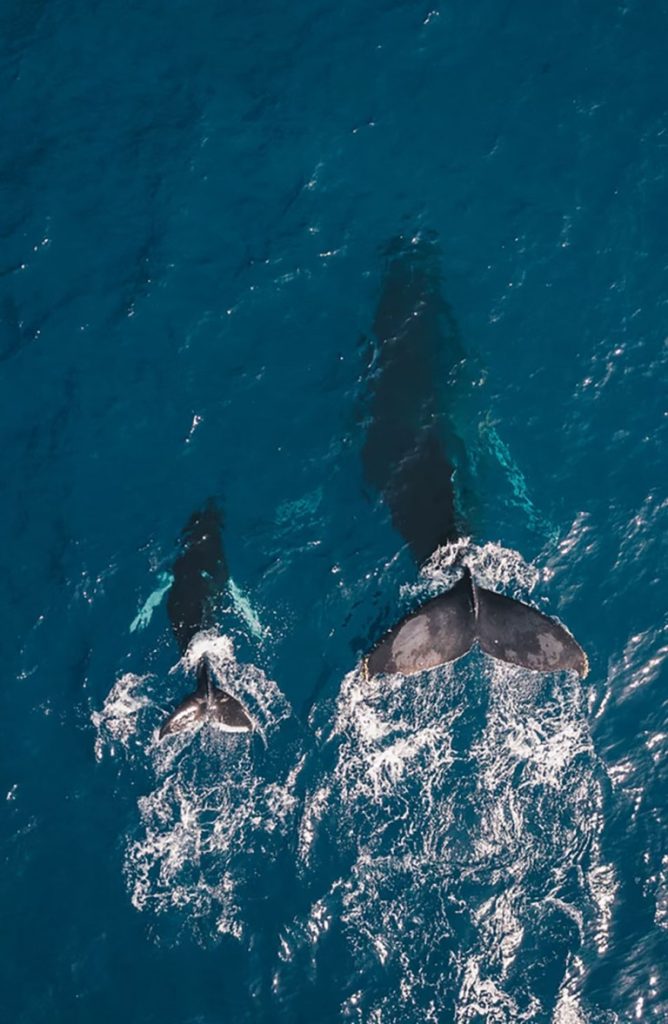
Having a blast
Recently, news of the surveys and the possible threat to whales from underwater noise blasted into headlines across South Africa. Videos of stranded whales went viral on social media. On Sunday, 21 November, protesters with placards gathered at Cape Town harbour where the Amazon Warrior, the vessel hired to carry out the survey, was set to arrive. Nearly 200 protesters hoped to “unwelcome” the 130m vessel and to vent their disapproval of the planned survey and the destruction feared.
The vessel arrived off Cape Town at 8.15am but didn’t enter the harbour. Meanwhile, protesters gathered at Shell petrol stations across the country to raise public awareness of the survey, and there have been calls to boycott Shell petrol stations, specifically Shell Ultra City just outside Mthatha, the former capital of the old Transkei homeland, through which much traffic to the Wild Coast must pass. Over the past week protests have continued to gain momentum across the country.

What the Shell is going on?
The survey was set to begin as early as 1 December 2021. Over four to five months, shockwaves would be fired by “an array of multiple airguns”, towed by the Amazon Warrior through a vast area to assess oil and gas deposits beneath the seabed in what is known as the Transkei Block – Exploration Right 12/3/252. This 6,011km2 area, between Port St Johns and Morgan’s Bay, is about 20km offshore where the depth ranges from 700m to 3,000m.
What does Shell say about the protests?
“At Shell, we respect the right of everyone to express their point of view. We only ask that they do so with their safety and the safety of others in mind. We can confirm we are operating within our legal right and have met all our obligations concerning the survey,” Shell’s public relations officer, Pam Ntaka, told the Highway Mail.
Shell South Africa chairperson Hloniphizwe Mtolo, who was born and grew up not far from the Wild Coast, assured the Mail & Guardian that if the planned seismic survey was unsafe Shell wouldn’t be doing it. “We need to co-exist with nature. As Shell… when we do these kinds of activities, we do the best that we can to make sure that we do not harm other species and the environment,” he said.
SLR Consulting, which distributed the 30-day seismic survey notification to the public on Shell’s behalf, told Roving Reporters it was collecting comments received and these would be collated and shared with Shell.
Meanwhile, the Oceans not Oil Coalition, an activist group, has collected more than 300,000 signatures on its change.org petition. The petition calls on Minister of Forestry and Fisheries and Environmental Affairs Barbara Creecy to withdraw approval of the Wild Coast seismic survey application.
Wasn’t me
The Department of Forestry, Fisheries and the Environment noted in a statement on 22 November 2021 that it had not been involved in considering the application or making a decision authorising the seismic survey. It said concerns about the survey, to be conducted by Shell and privately owned exploration company Impact Africa, had been noted by the department, but pointed out that the minister of mineral resources and energy was responsible for the administration of the Mineral and Petroleum Resources Development Act and had authorised the survey.
You might not expect the Department of Minerals Resources and Energy to issue environmental authorisations for mining, but ever since a change in the regulation in 2014, it has. In terms of the National Environmental Management Act of 1998 and the National Environmental Management: Waste Act of 2008, the mineral resources minister is responsible for issuing environmental authorisations and waste management licences for mining and related activities. The minister of environmental affairs may appeal these.
Activists believe the wrong department has been given responsibility for environmentally sensitive decisions – a case, they argue, of the fox being put in charge of the hen house. Nevertheless, the authorisations have been granted and cannot be undone without taking the matter to court.
What of the whales?
So, assuming the seismic survey goes ahead, what will happen to the whales?
According to Oceans not Oil’s website, a 2016 seismic survey extended into the whale migration period, and coincided with the highest recorded whale and dolphin strandings yet on the KwaZulu-Natal coast.
Whether the survey caused the strandings is not clear. It should also be noted that by the time the Wild Coast seismic survey starts many humpbacks will already be well on their way to the Southern Ocean, or have arrived there. On the other hand, Delport tells me that even outside peak season, humpbacks are occasionally seen in southern African waters, some even further north than Mozambique.
Dr Simon Elwen, a marine mammal scientist and director of Sea Search Research and Conservation, a scientific organisation focusing on marine mammals, said seismic surveys in South Africa apply a number of measures to lessen harm to marine mammals. These include restricting surveys to “low whale season”. But, like Delport, he pointed out there was no such thing as a “no-whale season” in the region. Some species are resident and even some of our migratory whales are found year-round, although more frequently from June to October.
Elwen is in no doubt that big bangs affect whales. “Loud noises from seismic surveys impact all life forms, from plankton and coral to fish and whales,” he said.
Whales and dolphins are very “acoustic” animals, using sound to navigate, find food and communicate with each other, Elwen said. He explained that marine mammals are sensitive to noise and seismic surveys have been shown to cause changes in whale singing – the frequency of sounds, how often they sing, and the volume. Whales have also been observed moving away from the source of sounds and reduction in whale sightings have been shown over thousands of kilometres.
Emotive
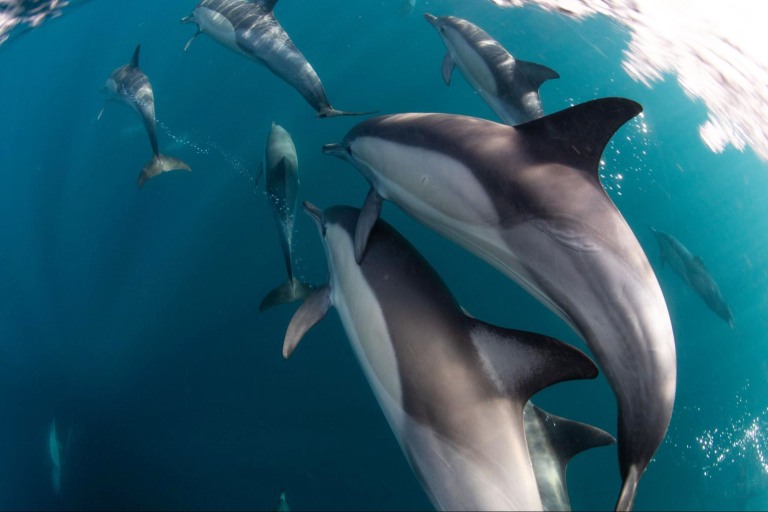
However, Elwen also notes that despite more than 40 years of seismic surveys there isn’t a single study showing a clear link between seismic surveys and the stranding of an individual or multiple whales, dolphins or even fish. He feels the emotive images of dead whales stranded on beaches being shared on social media are highly misleading.
He said that naval sonar, which has been known to cause the death of whales, is a completely different type of sound to what is used in seismic surveys. Naval sonar has been linked to strandings of many species of marine mammals, especially deep-diving species. It frightens these species, like beaked whales, causing them to rush to the surface to escape the noise. As they bolt from depth, the rapidly decreasing pressure causes nitrogen in their bodies to form bubbles, resulting in decompression sickness, much the same as “the bends” which affect human divers, and sometimes with similar consequences – death. He stressed that this type of response has never been observed during seismic surveys for oil and gas exploration.
Elwen said passive acoustic monitoring and onboard marine mammal observers were mandatory. But he added that the latter measure is somewhat flawed because marine mammals and fish are known to respond to blasting kilometres away from the source of the sound and, of course, they’re under water, well beyond an observer’s ability to detect them.
Observers halt blasting if it’s still in the ramp-up phase, he said, but if a whale swims through the array once it’s running at full capacity, blasting continues. Whales do swim through arrays a fair bit, Elwen explains, which is why most people in the seismic survey industry are a little baffled about what activists are up in arms about.
What if the wider effects of seismic surveys can’t be seen from the control deck? Perhaps weak individual whales are affected – those that are hungry or starving. Migratory whales on Africa’s east coast have not eaten for months when they begin their long journey back to the Southern Ocean. Elwen says there are often whale strandings during this time. Perhaps hunger affects whales’ navigation abilities or they’re less inclined to change course – to avoid the blasting.
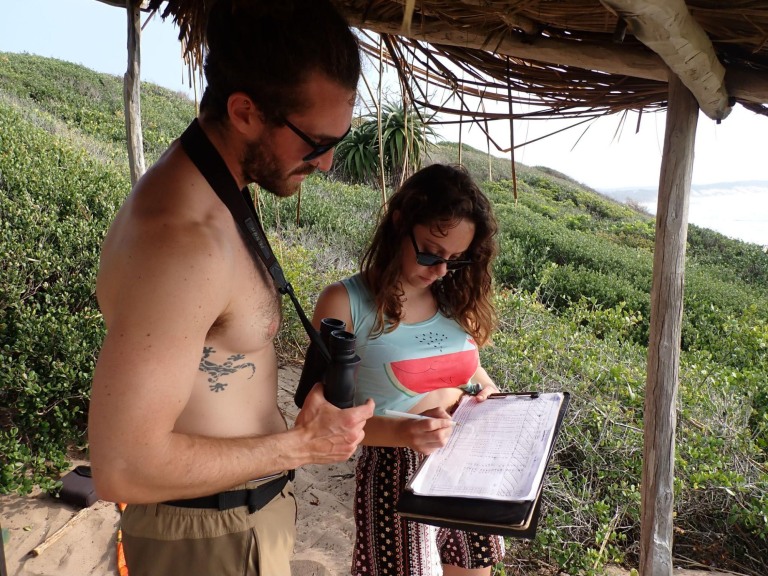
Oil be dammed
Beyond concerns for marine mammals, Elwen questions the need for seismic surveys – from a broader, environmental-energy perspective. “Many countries are choosing to leave their oil reserves in the ground. South Africa has so many world-leading environmental policies, and great potential for renewables – why not on this, too?”
Dr Judy Mann, the conservation strategist for the South African Association for Marine Biological Research, agrees with Elwen. She wants to see investment in renewable energy and a move away from fossil fuel. She points out that at the recently adjourned COP26 climate talks in Glasgow, the international community pledged more than R131-billion to help South Africa reduce its reliance on fossil fuels.
She feels “that the potential short-term, non-sustainable benefits to be gained from oil and gas are largely outweighed by the environmental risks posed by exploring for, and using, these non-renewable energy resources, especially along this vulnerable coastline”.
Economy matters
But while Mann, Elwen and many others would like to see the country move to renewables, there are doubts about how quickly this might happen
Aiden Biccard, a marine scientist involved in assessing the impact of marine mining and the recovery of mined areas, said: “Sadly, we are not in a position to move entirely to renewable energy sources yet in South Africa, but, hopefully, some day we will be.”
On the uproar around the seismic surveys planned for the Wild Coast, Biccard called for less heat and more light. “As scientists we need to remain impartial, conduct the necessary research, and let the data speak for itself rather than getting caught up in the hype and media,” he told Roving Reporters.
Shell boss Mtolo stresses the potential economic value of the seismic survey. If hydrocarbons (the chemical compounds that form the basis of crude oil, natural gas, coal and other energy sources) are confirmed to be beneath the seabed in sufficient quantity, it “will benefit the economy in a huge way. It will create jobs and ensure the future of the country is positive.”
Wild waters
Mann’s main concern appears to lie not so much with the planned seismic blasts, which have fired up many activists, but with the potential threat of oil spills if drilling and extractions go ahead and the catastrophic consequences this might have for marine life.
Powerful, unpredictable ocean conditions in the region mean “attempts to contain any accidental spillage or normal operational spillage would likely be unsuccessful”. “This, as one of the most powerful oceanic currents in the world, hurtles through the region, usually north to south, but sometimes reverses – while large-scale eddies peeling off the current further complicate the flow, often bringing offshore water to the coast.”
She explained that environmental impact assessments rate the risk of a catastrophic blowout, such as would cause a large-scale oil spill, as very low. However, “this does not consider the increased risks posed by the harsh, unique physical environment found off the Wild Coast”.
Elwen takes a similar view. He said spill modelling had been a “key weakness” of the environmental management programme for the exploratory drilling off KZN that was granted approval in 2019.
“They worked on ‘average’ conditions a lot – but there is clear evidence most accidents happen due to storms… and there is clear evidence that climate change… is making storms bigger and more frequent,” he said, citing a WWF report.

Upstream in Mozambique
It’s October and we are watching the humpback whales preparing to leave Zavora Bay. From here it’s 1,000km to the Wild Coast, after which the whales will continue their long swim to the Southern Ocean.
“Three spouts, one breach, it’s two adults and a calf,” calls out Mikel Gutiérrez Muto, the Zavora Marine Labs research coordinator, as I frantically fill in the data collection sheet and mark the pod’s position on the map. We’re back under the same palm frond, roofed lean-to from where Delport witnessed that newborn humpback’s first breath.
For more than a decade these biweekly surveys have taken place during high whale season. They are crucial for understanding population trends, allowing effective management measures for conservation. From these data researchers have discovered that humpbacks use Zavora Bay as a breeding area and not merely a migration passage.
The most recent analysis of the data indicates that warmer water correlated with fewer whale sightings. As the climate changes and new potential threats emerge, these long-term data sets become invaluable in helping scientists piece together the climate change puzzle. They have already warned that climate change may affect marine mammals who can only survive in waters between specific temperatures.
Climate change and its knock-on effects may have a bearing on where prey is found and in what quantities. In turn, this could affect the abundance of whales, their migration patterns, community structures and susceptibility to disease and contaminants. Ultimately, there may be consequences for the reproductive success and survival of these marine mammals.
At the end of the peak humpback season in Zavora the whales are hungry and are heading down southern Africa’s east coast, en route to the chilly waters off Antarctica. These whales make the longest migration of any mammal. Once in the Southern Ocean, over summer they will gorge themselves on great quantities of microscopic krill. They will build up fat reserves and next year in June, return to mate and give birth in Zavora’s warm tropical waters.
The circle of life resumes. Or will it?
As Elwen reminded me, whales don’t have an off-season; some may well be caught in the blasting.
It’s comforting to note that there have been seismic surveys worldwide in the past, including in South Africa’s waters, and these do not appear to have led to the catastrophe some activists feared. But many would counsel erring on the side of caution.
Should Shell and other oil companies be obliged to prove the practice is safe, or is it up to conservationists, opponents of seismic blasting, to prove the contrary? Where does the burden lie?
The world moves on
Biccard says that if the mitigation measures, including onboard observers and passive acoustic monitoring (essentially an underwater microphone listening out for marine mammals), are adhered to and the correct protocols are followed, the probability of injury to whales and dolphins should be substantially reduced.
Mtolo stresses that seismic surveying has a long history. “This is not the first time that surveys of this kind are done. We do thousands of these and thousands are done across the globe. A large portion of the public does not understand this is something that can be done in the course of the day, but most importantly the extent that companies, and Shell being the lead one in this space, goes through in terms of making sure that there is no harm to sea life and no harm to the environment. We do it correctly and in a manner that is in line with global best practice.”
But in many ways, the world has moved on. The arguments for a switch from fossil to renewable fuels seem more compelling. Three decades ago, most of the world supported an end to whaling. Similar common purpose is needed if we are to safeguard our seas – the humpbacks whales and the many other creatures that live in it. – Roving Reporters

(Photo: Ken Finlay)

Roving Reporters correspondent and conservation biologist Rio Button spent three months at MAR Expedition’s lab in Zavora, Mozambique, helping with research on whales, rays, sharks, turtles, fish and sea slugs. Once the hungry humpback whales had left Zavora Bay, and with her visa about to expire, Button too left Mozambique and headed south for the summer.




